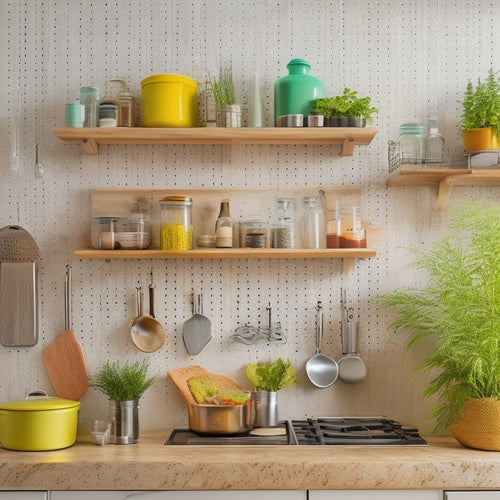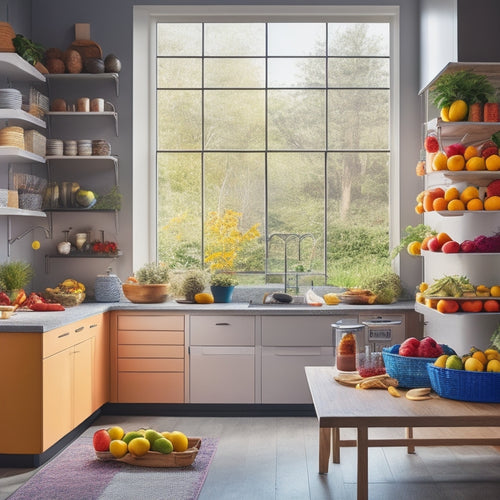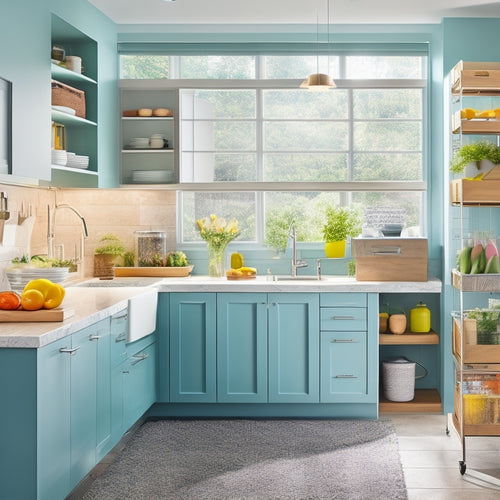
Easy Kitchen Pantry Organization for Beginners
Share
To easily organize your kitchen pantry, start by evaluating the space, measuring dimensions, and noting any obstructions. Next, purge expired or unused items, and categorize food and beverages into groups. Assign a home for each group, keeping frequently used items accessible. Utilize vertical storage options like shelves, hooks, and pegboards to maximize space. Create zones for easy access, and maintain cleanliness by wiping down shelves and updating inventory regularly. By following these steps, you'll be well on your way to a stress-free pantry. Now, let's get started on creating a functional layout that works for you.
Key Takeaways
• Measure your pantry's dimensions to maximize storage space and identify areas for improvement.
• Purge expired, stale, or unused items to declutter your pantry and create a more organized space.
• Categorize and group similar items together, assigning homes for each food group to maintain organization.
• Utilize vertical storage options like shelves, hooks, and pegboards to optimize storage space and accessibility.
• Label items with expiration dates and implement a color-coding system to ensure easy identification and retrieval.
Assessing Your Kitchen Pantry Space
Take stock of your kitchen pantry's current state by measuring its dimensions, identifying the type and number of shelves, and noting any obstructions or challenges that may impact your organizational plans. This will give you a clear understanding of what you're working with, helping you maximize space and organize efficiently.
Next, consider the items you need to store. Think about the frequency of use, size, and shape of each item. This will help you determine the best storage solutions and layouts for your pantry.
As you assess your pantry, keep safety in mind. Make sure you have enough clearance between shelves for easy access and to prevent accidents. Consider installing shelves or storage units with sturdy bases to prevent tipping or collapse.
Purging and Decluttering Essentials
Sort through your pantry's contents and identify items that are expired, stale, or no longer useful to you, as these will be the first to go in your purging and decluttering process. Be ruthless – if you haven't used it in the past year, it's probably safe to get rid of it. This will help you create a fresh start for your kitchen pantry organization project.
When decluttering, remember these essential tips:
-
Check expiration dates and toss anything past its prime
-
Remove any broken or damaged items that can't be repaired
-
Consider donating unopened, non-perishable items to a local food bank or charity
Categorizing Food and Beverage Items
Now that you've purged and decluttered your pantry, it's time to categorize your food and beverage items.
You'll want to group similar foods together, such as grains, canned goods, and baking supplies, to make meal planning and cooking more efficient.
Food Grouping Strategies
You'll find it helpful to group similar food and beverage items together, categorizing them into sections like baking supplies, snacks, and canned goods. This strategy will make it easier to locate items when you need them, reducing the risk of expired or spoiled food going unnoticed.
When implementing your food grouping strategy, consider the following tips:
-
Assign a home: Designate a specific shelf or container for each food group to maintain organization and prevent clutter.
-
Use a labeling system: Clearly label each section or container so you can quickly identify what's inside.
-
Keep frequently used items accessible: Store your most frequently used items in easy-to-reach locations to save time and effort.
Beverage Storage Options
After grouping your food items, turn your attention to categorizing and storing beverages, which require specific storage solutions to maintain their flavor, quality, and freshness. Start by designating a specific area for your beverages, such as a beverage station or a zone on a shelf.
You'll want to store cold beverages, like soda, juice, and water, in a cool, dry place, like the refrigerator or a temperature-controlled storage solution.
For hot beverages, like coffee and tea, consider a glassware display on a creative shelving unit. This will keep them visible and easily accessible. When storing coffee and tea, make sure they're in airtight containers to preserve their flavor and aroma.
If you have a lot of coffee or tea accessories, like creamers, sweeteners, or stirrers, store them in a nearby basket or bin to keep them organized and within reach.
Remember to store beverages in a safe and accessible location, away from direct sunlight and heat sources. By categorizing and storing your beverages thoughtfully, you'll be able to enjoy your favorite drinks while keeping your pantry organized and clutter-free.
Assigning Zones for Easy Access
Now that you've categorized your food and beverage items, it's time to assign zones for easy access within your pantry.
You'll want to define specific areas for different types of food storage, such as a baking zone or a snack zone, to make meal prep and grocery shopping a breeze.
Pantry Zones Defined
By dividing your pantry into distinct zones, you can create a functional layout that streamlines your cooking and food storage routine. This pantry organization strategy allows you to allocate specific areas for different types of items, making it easier to find what you need when you need it.
To achieve this, consider assigning zones based on the frequency of use, category, or cooking task.
For example:
-
Baking zone: Store baking supplies, such as flour, sugar, and baking powder, near the countertop or a designated baking station.
-
Snack zone: Designate a shelf or bin for healthy snacks, like nuts, dried fruits, and energy bars, for quick access.
-
Meal prep zone: Allocate space for meal prep essentials, such as spices, oils, and condiments, near the cooking area.
Food Storage Areas
Assign dedicated zones within your pantry for food storage areas that require easy access, such as a 'canned goods zone' or a 'breakfast essentials zone', to guarantee you can quickly grab what you need when cooking or preparing meals. This strategic organization will save you time and reduce stress in the kitchen.
Consider container options like baskets, bins, or canisters to store items like pasta, rice, or snacks. Label each container so you can easily identify what's inside. For shelving solutions, install adjustable shelves or use stackable shelves to maximize vertical space.
When organizing your food storage areas, prioritize items you use frequently, placing them at eye level or near the front of the shelf. Less frequently used items can be stored towards the back or on higher shelves. Implement a labeling system to categorize and identify contents, ensuring you can locate items quickly.
Categorize and Group
To optimize your pantry's functionality, categorize and group similar food items together. This includes baking supplies, snacks, or international ingredients. Assign specific zones for easy access. This will help you quickly find what you need, reducing meal prep time and stress.
When categorizing, consider the frequency of use and the type of items. For example, store heavy items at the bottom and lighter items on top to prevent accidents.
You can also:
- Label containers to identify contents at a glance
- Use baskets or bins to store small items, keeping them organized and out of sight
- Incorporate vertical space by using stackable shelves or baskets, maximizing storage capacity
Utilizing Vertical Storage Options
You can maximize your kitchen pantry's storage capacity by installing shelves, hooks, or a pegboard on the back of a door or wall, making the most of often-wasted vertical space. This is especially useful for storing items that you don't use frequently, like special occasion dishes or infrequently used cookbooks.
Consider using wall hooks to hang baskets or bins, keeping items like spices, oils, or snacks within easy reach. You can also install door racks or shelves to store items like canned goods, cleaning supplies, or cooking utensils. Make sure to secure any heavy items or shelves to the wall to prevent them from falling and causing injury or damage.
Maintaining Your Organized Pantry
Now that you've optimized your pantry's storage capacity, it's time to focus on maintaining your newly organized space to guarantee it remains clutter-free and functional over time. To secure your pantry stays organized, you need to establish a maintenance schedule. Set aside some time each week to tidy up your pantry, checking expiration dates, and restocking essentials.
Here are some organization tips to help you maintain your pantry:
-
Regularly clean and dust shelves: Prevent crumbs and spills from accumulating by wiping down shelves and dusting containers regularly.
-
Update your inventory tracking: Keep track of what you have in stock and what needs to be replenished to avoid overbuying or running out of essentials.
-
Review and adjust your labeling system: Make sure labels are still accurate and easy to read, and adjust as necessary to secure everything has a designated home.
Frequently Asked Questions
How Often Should I Clean Out Expired Food From My Pantry?
You should regularly clean out expired food from your pantry to maintain proper pantry organization and decluttering, ensuring food safety by checking expiration dates every 1-2 months and discarding spoiled items immediately.
Can I Use Old Bookshelves for Pantry Storage?
'Coincidentally, you're thinking of upcycling old bookshelves for pantry storage, and it's a brilliant idea! You can repurpose furniture to create DIY shelves, just make sure they're sturdy, clean, and dry to store your food safely.'
Are Stackable Containers Necessary for Pantry Organization?
You don't necessarily need stackable containers, but they do help with space optimization and visibility. Consider using labels on your containers to guarantee you can quickly identify what's inside, guaranteeing a safe and organized pantry.
How Do I Prevent Pests From Getting Into My Pantry?
To prevent pests from getting into your pantry, you'll want to maintain a clean and organized space, regularly wiping down shelves and containers, and storing food in sealed, airtight containers to deny pests access.
Can I Store Non-Food Items in My Kitchen Pantry?
"Your pantry is like a treasure chest, storing more than just food. You can store non-food items like household essentials, but prioritize organization and decluttering with storage solutions to maintain a safe and pest-free space."
Related Posts
-

Stylish Pegboard Storage for Open Kitchen Concepts
Stylish pegboard storage can completely enhance your open kitchen concept, merging practicality with contemporary fla...
-

Space-Saving Tiered Racks for Kitchen Storage
Space-saving tiered racks are your best solution for maximizing kitchen storage. They employ vertical space, allowing...
-

Sink Storage Solutions for Open-Concept Kitchens
To maximize storage in your open-concept kitchen, focus on clever under-sink solutions and vertical space utilization...


